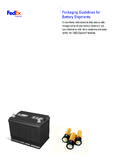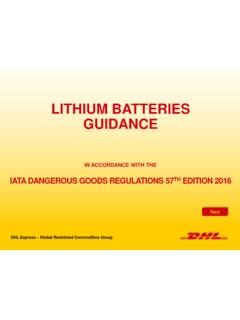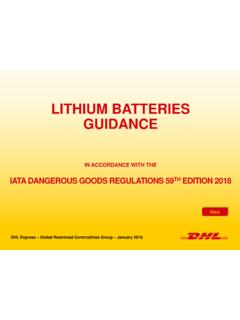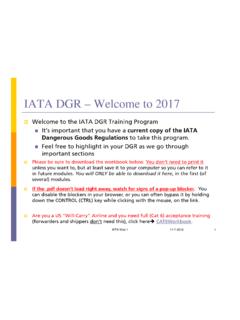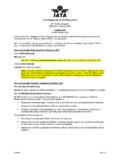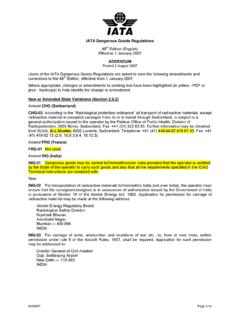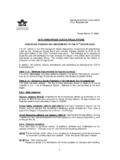Transcription of Packing and Labelling Dangerous Goods for …
1 SEM Page 1 of 14 Rev. 15 Dec 2016 Packing and Labelling Dangerous Goods for Transport Scope This document is meant to provide guidance to allow for the safe handling, packaging, and Labelling of Dangerous Goods , as defined by the Transportation of Dangerous Goods regulations (TDGR), at Thompson Rivers University (TRU). The regulations apply when Dangerous Goods are received and/or shipped by TRU personnel, when moving Dangerous Goods across a public road at TRU, and when shipping Dangerous Goods within Canada or internationally. The legislation governing transportation of Dangerous Goods for the above listed procedures is governed by the following acts, regulations , and technical documents.
2 Transportation of Dangerous Goods Act and regulations (Canada, 1992) ICAO Technical Instructions for the Safe Transport of Dangerous Goods by Air iata Dangerous Goods regulations (International Air Transport Association, 1999) The Canadian Environmental Protection Act (Canada, 1999) CNSC Transport Packaging of Radioactive Materials Regulation (Canada, 2000) British Columbia Environmental Management Act (2003) British Columbia Waste Discharge Regulation (2004) IAEA regulations for the Safe Transport of Radioactive Material TS-R-1 (2005) British Columbia Hazardous Waste Regulation (2009) Human Pathogens and Toxins Act (2015) Human Pathogens and Toxins regulations (2015) Canadian Biosafety Standard, 2nd ed.
3 (2015) Canadian Biosafety Handbook, 2nd ed. (2016) Compliance Department heads and directors are responsible for ensuring designated personnel responsible for safely handling Dangerous Goods as outlined in this document, comply with TDGR and are adequately trained. Training TDG training and demonstrated competency are mandatory for any individual shipping or receiving Dangerous Goods at TRU. Following training program completion, TGD certificates are valid for 3 years. After expiry, retraining is required. Untrained individuals may handle Dangerous Goods in the absence of certification, however, this is only permissible in the presence of a trained and certified individual.
4 Please contact the Biosafety Officer about TDG training at TRU. SEM Page 2 of 14 Rev. 15 Dec 2016 Shipping and Receiving At TRU, Dangerous Goods may only be shipped and/or received by TDG trained personnel or individuals under the supervision of TDG certified individuals. Damaged Packages Damaged or non-compliant packages are to be accepted by TRU receivers. However, after accepting the package, the receiver(s) should note any damage or non-compliance on the accompanying shipping document and report the same to the shipper for reimbursement if applicable. If the package is damaged to such an extent that the contents are compromised, the package and its contents will be disposed of as hazardous waste as per TRU s waste disposal policies.
5 If the damage results in a large spill, contact the TRU OSEM. Material Classification Certified TRU shippers/receivers are responsible for proper material classification under Canada s TDGR. If unsure of the designation, related shipping documentation, Safety Data Sheets (SDS), contacting the manufacturer, and OSEM consultation may aid in classifying the material in question. A guide to classifying infectious substances and toxin classifications can be found in this document in Appendix A. Individuals shipping Dangerous Goods must keep a proof of classification for all Dangerous Goods offered for transport or imported into Canada for a 5-year period after shipping.
6 Proof of classification must include the date of classification, the technical name of the Dangerous Goods , and the classification of Dangerous Goods . Proof of classification can include the following: - A test report - A lab report - An SDS with a matching Chemical Abstracts Service (CAS) number or PSDS from the Public Health Agency of Canada (PHAC) TDGR divide Dangerous Goods into 9 classes, based on the type of hazard they present. These divisions are outlined in Table 1 below: SEM Page 3 of 14 Rev. 15 Dec 2016 Table 1: Classification of Dangerous Goods Class Division Characteristics 1 Explosives (Sections ) A substance or article with a mass explosion hazard.
7 A substance with a projection hazard but not a mass explosion hazard. A substance or article which has a fire hazard and either a minor blast hazard or a minor projection hazard, or both, but does not have a mass explosion hazard. A substance or article which presents no significant hazard beyond the package in the event of ignition or initiation during transport. A very insensitive substance with a mass explosion hazard. Extremely insensitive article with no mass explosion hazard. 2 Gases (Sections ) A flammable gas which is easily ignited and burns. A non-flammable, non-toxic, non-corrosive gas.
8 A toxic gas. 3 Flammable Liquids (Sections ) None A flammable liquid with a closed-cup flash point less than or equal to C. 4 Flammable Solids (Sections ) A flammable solid which is readily combustible and may cause fire through friction or from heat retained from manufacturing. A spontaneously combustible substance that ignites when exposed to air. A water-reactive substance which emits flammable gas when it comes into contact with water. 5 Oxidizing Substances, Organic Peroxides (Sections ) An oxidizing substance which may yield oxygen and contribute to the combustion of other material.
9 An organic peroxide which releases oxygen readily and may be liable to explosive decomposition, or sensitive to heat, shock, or friction. 6 Toxic and Infectious Substances (Sections ) A toxic substance that is liable to cause harm to human health. An infectious substance. 7 Radioactive Materials (Sections ) None Radioactive materials as defined in the Packaging and Transport of Nuclear Substance regulations . 8 Corrosive Substances (Sections ) None Solids or liquids such as acids or alkali materials that cause destruction of the skin or corrode metals. 9 Miscellaneous Products, Substances, or Organisms None A regulated substance that cannot be assigned to any other class.
10 It includes genetically modified organisms (GMOs), marine pollutants, and substances transported at elevated temperatures. As well, some Dangerous Goods from each group are assigned Packing classes. These classes are determined by physical and chemical testing described in Part 2 of the TDGR. Table 2 below briefly outlines the Packing classes used by Transport Canada to classify materials. SEM Page 4 of 14 Rev. 15 Dec 2016 Table 2: Packing Groups Packing Group Level of Hazard I Very hazardous substance II Hazardous substance III Moderately hazardous substance Packaging regulations As per TDGR, shipping of some Dangerous Goods above certain specified quantities, is prohibited in the absence of a developed Emergency Response Assistance Plan (ERAP).




